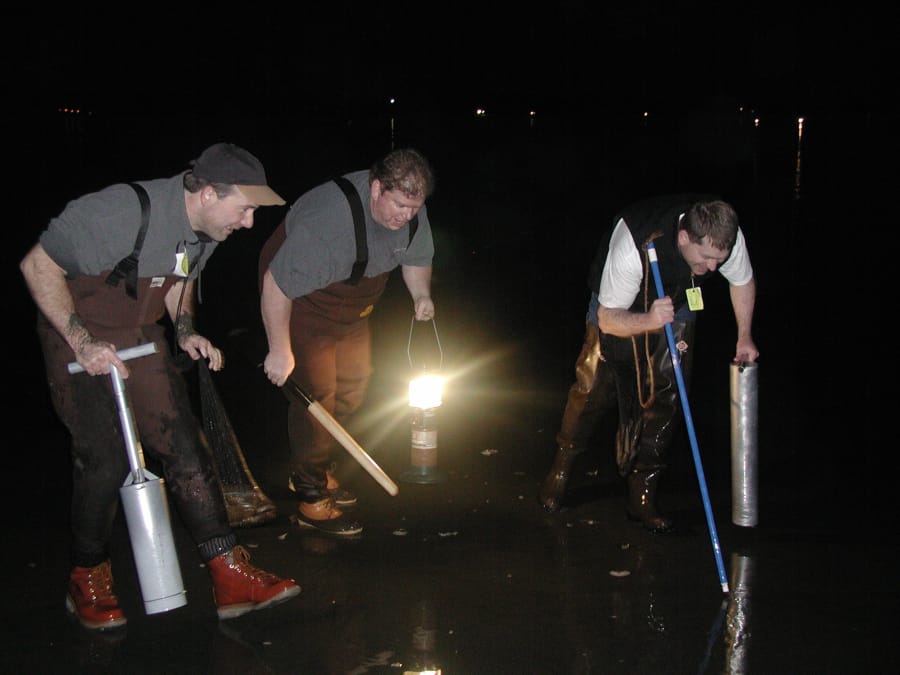Clammers in Southwest Washington will finally get to dig for razor clams on the Long Beach Peninsula this coming Saturday, although high surf could scuttle the only dig planned for the peninsula’s beaches this year.
State shellfish managers with the Washington Department of Fish and Wildlife approved the dig after marine toxin tests showed the clams are safe to eat.
Saturday’s low tide will be a minus 1.4 feet at 6:20 p.m.
Clam digs on other Washington beaches were also approved starting on Thursday.
While razor clams are available in good sizes and numbers on Washington’s other beaches, the WDFW has kept Long Beach closed because most of the clams are small. The department wanted the clams to have some time to grow.
The clam population took a hit when high flows of fresh water out of the Columbia River in spring and summer of 2017 dropped the salinity to levels that were unhealthy for the clams along the Long Beach Peninsula.
WDFW’s summer clam assessments showed that there were few large clams, which the diggers prefer.
“We have done some spot diggings (to assess the clams),” said Dan Ayers, the coastal shellfish manager for the WDFW, “but we can’t do a full assessment in winter.”
What the spot digs did turn up were small clams.
“Overall the clams are pretty small, and there are a lot of them in the three-inch range. There are not going to be a lot of big guys,” he added. “Up at the north end of the peninsula, where we usually see more big ones, there is still not a lot of big clams.”
On Oregon’s Clatsop beaches the situation is even worse, and the Oregon Department of Fish and Wildlife has closed the beaches until at least March 1, so people can’t cross the Columbia to dig razors either.
Clam digging around the holidays is a tradition among many families, and hopefully this dig will give people a chance to get a few clams before Christmas.
The dig will also help state shellfish managers out by giving them a better idea of the average size of the young clams.
High surf could end up spoiling the fun. The seas have been running heavy this month, but the surf forecasts have shown a possible drop for Saturday.
This time of year brings evening tides and much of the digging happens after dark, which makes it extremely dangerous when the surf is high. Sneaker waves can easily sweep up the entire beach.
Two women were killed last year along Washington beaches when high surf swept them offshore.
Diggers are reminded never to dig clams alone, and someone in the group should always keep an eye on the ocean.
If the weather is too rough, Ayers said the dig will be rescheduled.
Since these are evening tides, clammers will need to bring either a lantern or a powerful flashlight in order to spot the shows, small circular dimples left in the sand by the clams. Once a clam is found they are either dug by hand, or pulled from the sand with clamming guns.
The department is considering opening Long Beach for a few digs next year, but they are waiting to see what this dig turns up.
Toxins a possible threat
While recent testing shows Washington’s clams are safe to eat, there have been signs that marine toxins could be a concern for some of the upcoming digs. Ayers reported that the diatoms that are responsible for the toxins have been present along the coast, although in low numbers.
“In December it is odd to see that,” he remarked.
Another concern for Ayers is the fact that many clam diggers may try to return the small clams to the sand, something the juvenile clams almost never survive.
Ayers is planning on hitting the beach during the dig himself to talk to the clammers and see how they feel about what they are finding.
“I want to see if they are getting large enough clams to be happy, or if they are not happy,” he said.
Local clammers may drive north to other Washington beaches and find plenty of sizable clams.
All diggers 15 or older must have an applicable 2018-19 fishing license to harvest razor clams on any beach. Licenses, ranging from a three-day razor clam license to an annual combination fishing license, are available on WDFW’s website at https://fishhunt.dfw.wa.gov and from license vendors around the state.
Under state law, diggers at open beaches can take 15 razor clams per day and are required to keep the first 15 they dig, regardless of size or condition. Each digger’s clams must be kept in a separate container.
This Week’s Clam Digs
Thursday, 4:51 p.m.; -0.3 feet;
Twin Harbors, Mocrocks
Friday, 5:35 p.m.; -1.0 feet;
Twin Harbors, Copalis
Saturday, 6:20 p.m.; -1.4 feet;
Long Beach, Twin Harbors, Mocrocks
Sunday, 7:05 p.m.; -1.6 feet;
Twin Harbors, Copalis




